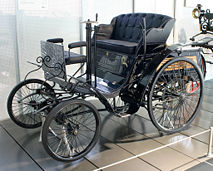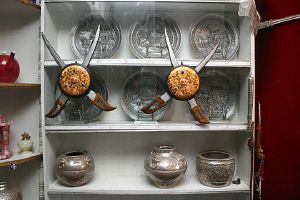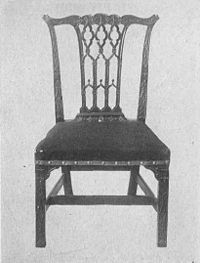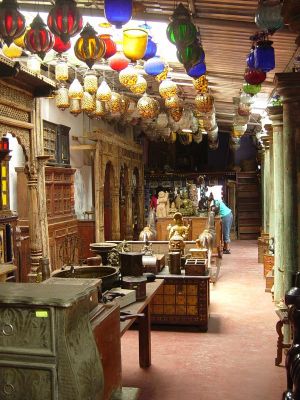Antique

An antique (Latin: antiquus; old) is a collectible item desirable because of its age, rarity, condition, utility, or other unique features. It is an object which has reached an age which makes it a witness of a previous era in human society.
Antiques are usually objects which show some degree of craftsmanship, or a certain attention to design such as a desk or the early automobile. In a consumer society, an antique is above all an object whose atypical construction and age give it a market value superior to similar objects of recent manufacture. Any historical museum makes a considerable use of antiques in order to illustrate historical events and give them a practical context.
Just about any object can become an antique if it survives long enough, but value of an antique in the market place is determined by its appeal and social acceptance.
The term "antique" is pejorative in some instances, usually to depreciate the usefulness of an object or a procedure.
Antiques are bought at antique shops, or passed down as an estate. Some valuable antiques can be bought from antique dealers and auction services or purchased online through websites and online auctions. Antique dealers are often members of national trade associations, many of which themselves belong to CINOA, a confederation of art and antique associations across 19 countries, representing five thousand dealers.
Definition of antique
The definition of antique varies from source to source, product to product and year to year. But, some time-tested definitions of antique deserve consideration:
- An item which is at least 100 years old and is collected or desirable due to rarity, condition, utility, or some other unique feature. Motor vehicles,tools and other items subject to vigorous use in contrast, may be considered antiques in the U.S. if older than 25 years, and some electronic gadgets of more recent vintage may be considered antiques
- antique (noun) - Any piece of furniture or decorative object or the like produced in a former period and valuable because of its beauty or rarity.
Using this definition allows distinctions between genuine antique pieces, vintage items and collectible objects.
The alternative term antiquities is commonly used to refer the remains of ancient art and everyday items from antiquity, which themselves are often archaeological artifacts.
An antique by definition is anything 100 years or older. People sometime mistake collectibles for antiques. A true collectible is anything that is 50-100 years old. Vintage items are also confused for antiques and collectibles. A true vintage item is anything that is from 1950's,60's and 70's and is "retro" to the time it was made.
Antiquing
"Antiquing" is the act of shopping, identifying, negotiating, or bargaining for antiques. Items can be bought for personal use, gifts, and in the case of brokers and dealers, profit. Antiquing is performed at garage sales, estate sales, resort towns, antiques districts, collectives, and international auction houses.
Note that the word "antiquing" may also refer to the art of making an object appear antique through distressing or applying an antique looking paint application.
Antique furniture
The collecting of antique furniture is a particularly popular area of antiques due to the practical characteristics of these antiques. Antique furniture includes dining tables, chairs, bureaus, chests etc. The most common woods are mahogany, oak, pine, walnut and rosewood. Each wood has its own distinctive grain and colour. Many modern pieces of furniture often use laminate or wood veneer to cheaply achieve the same effect. There are a number of different styles of antique furniture depending on when and where it was made. The most common include Arts & Crafts, Georgian, Regency and Victorian.
Antique furniture is the collective term for collectible movable objects which are old and is collected or desirable because of its age, rarity, condition, utility, or other unique features. It is an object which has reached an age which makes it a witness of a previous era in human society. Very early humans were nomads, moving from location to location, and survived from only what nature provided. Furniture to them was no more than a log to sit on. As they learned to cultivate the soil, much of their survival hunting activities ceased and their need for community work grew. They established homes (very crude by today's standards) beside their cultivated land – simple huts of wood and reed, perhaps daubed with clay or mud, and later of stone and baked clay bricks. It was this "home" and community gathering (civilization) that created the need for furniture.
Antique furniture may support the human body (seating furniture and beds) that show some degree of craftsmanship, provide storage, or hold objects on horizontal surfaces above the ground. Storage furniture (which often makes use of doors, drawers, and shelves) is used to hold or contain smaller objects such as clothes, tools, books, and household goods. Furniture can be a product of artistic design and is considered a form of decorative art. In addition to furniture's functional role, it can serve a symbolic or religious purpose. Domestic furniture works to create, in conjunction with furnishings such as clocks and lighting, comfortable and convenient interior spaces. Furniture can be made from many materials, including metal, plastic, and wood. Cabinetry and cabinet making are terms for the skillset used in the building of furniture.
The earliest furniture was understandably very primitive and only practical, but gradually the furniture also began to have more importance and it became decorated. At this point, furniture became an early status symbol. Wealthy homeowners became more refined and demanded that their furnishings reflect their status and lifestyles.
Early furniture has been excavated from the 8th-century B.C.E. Phrygian tumulus, the Midas Mound, in Gordion, Turkey. Pieces found here include tables and inlaid serving stands. There are also surviving works from the 9th-8th-century B.C.E. Assyrian palace of Nimrud. The earliest surviving carpet, the Pazyryk Carpet has been dated between the 6th and 3rd century B.C.E. and was discovered in a frozen tomb in Siberia. Recovered Ancient Egyptian furniture includes a 3rd millennium B.C.E. bed discovered in the Tarkhan Tomb, a c.2550 B.C.E. gilded set from the tomb of Queen Hetepheres, and a c. 1550 B.C.E. stool from Thebes. Ancient Greek furniture design beginning in the 2nd millennium B.C.E., including beds and the klismos chair, is preserved not only by extant works, but by images on Greek vases. The 1738 and 1748 excavations of Herculaneum and Pompeii introduced Roman furniture, preserved in the ashes of the 79 C.E. eruption of Vesuvius, to the eighteenth century.
Antique shop

An antique shop (or antiques shop, especially in the UK) is a retail store specializing in the selling of antiques. Normally their stock is sourced from auctions, house clearances, etc. By their very nature, they sell unique items and are typically willing to buy items, even from individuals as well as sell them. The quality may vary from very low to extremely high and expensive, depending on the nature and location of the shop.
Restoration of antiques
Antiques restoration refers to either the practice of "restoration"- restoring an antique or work of art to a like-new condition (or what might be perceived by a viewer or potential buyer as like-new), or "conservation"- the practice of preserving an antique or work of art against further deterioration.
Restoration
Restoration can be as simple as light cleaning to remove disfiguring dirt or grime, such as on the surface of a painting, or it may include near complete rebuilding or replacement, as might be the case with old automobiles or furniture. Often done in preparation for sale, or by an collector upon acquiring a new piece, the main goal of restoration is to "restore" the original appearance or functionality of a piece. There is a lot of difference between restoring and repairing. You may achieve functionality with a repair, but to restore an item properly is an art-form. Finishes might/may be stripped and redone, but it is essential that the original patination is retained, if possible. Stripping is only done as a last resort, especially with antique furniture. Engines might be rebuilt with new parts as necessary, or holes in a [silver] pot might/may be patched. While some of these practices are frowned on by many museums, scholars, and other experts, for many people there is little value in an antique that is unusable or undisplayable. Bad restoration is the bane of a trained restorer. Working on someone elses bad repair is the worst possible situation.
Restorers are often trained craftspersons, such as furniture makers, mechanics, or metalsmiths. Some have years of experience in their fields, others are self-taught volunteers. Many of the antique aircraft around the United States are restored by trained aircraft engineers assisted by volunteers, some of whom are men who flew those same aircraft years ago.
Conservation
In contrast, conservation typically aims to preserve the remaining material as being worthy or valuable on its own without necessarily being functional or looking new. There are several criteria for what work is necessary and how far to take any work performed. Chiefly, is the object (book, painting, car, statue, etc.) actively deteriorating? Slowing or stopping deterioration and eliminating or mitigating the root cause is the first task of the conservator. To this end, conservators are usually trained in the science of materials and chemistry, as well as art history, archaeology, and other disciplines related to their areas of expertise. ]
External links
- The San Francisco Fall Antiques Show, benefiting Enterprise for High School Students, CA
- Winter Antiques Show, benefiting East Side House Settlement, NY
- The latest news about the antiques & collectibles market
- Conker Collectables - making antiques fun for children
- BBC Antiques section - the BBC website has an informative section on antiques.
- Online Dictionary of Marks for Antiques & Collectibles
- Antiques Topic
- Antiques TV Channel
- Sacramento Street Shopping District, San Francisco, CA
- Antique Furniture Timeline covering the period 1650 to 1950.
- English Periods and Styles of Antique Furniture.
- Furniture Timeline.
- How To Collect Antique Furniture
- Antique Furniture Care
- Antique Furniture at AntiquesTopic.com
- Classified ads from antique dealers
- Antique Shops A to Z directory for North America
- Antique-Shop.com
- List of Auction shops catorgized by zip code
- Classified ads from antique dealers
- Webteek - Antiques Online
Credits
New World Encyclopedia writers and editors rewrote and completed the Wikipedia article in accordance with New World Encyclopedia standards. This article abides by terms of the Creative Commons CC-by-sa 3.0 License (CC-by-sa), which may be used and disseminated with proper attribution. Credit is due under the terms of this license that can reference both the New World Encyclopedia contributors and the selfless volunteer contributors of the Wikimedia Foundation. To cite this article click here for a list of acceptable citing formats.The history of earlier contributions by wikipedians is accessible to researchers here:
The history of this article since it was imported to New World Encyclopedia:
Note: Some restrictions may apply to use of individual images which are separately licensed.


